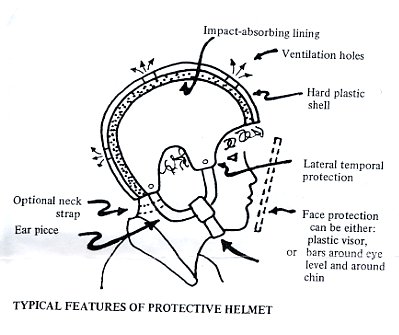NEW SEARCH NEW SEARCH, STATE - WA
First
DISCLAIMER:
Whilst all care is taken to provide accurate information with respect to the item described, the Independent Living Centre (ILC) is not involved in product design or manufacture, and therefore not in a position to guarantee the accuracy of the information provided. Selection of equipment, which is both suitable and appropriate for individual needs remains the responsibility of the person(s) considering requisition, and no responsibility is taken by the ILC for any loss or injury caused through use of the equipment or alleged to have arisen through reliance upon information provided. As information is subject to change any enquiries should be directed to the manufacturer.
Item Details
A Guide To Selecting Head Protection
ILC Reference NO 12:54:999
Item sourced from ILC WA database

Short Description
The aim in use of a helmet or head protection is to minimise and prevent trauma. Selection therefore needs to consider materials, fit and contour, comfort and appearance.
This is a guide only
Price Guide
Refer to supplier details for pricing
More Details
Considerations for use:
Size and Fit - the helmet should conform to the size and shape of the user's head. If it is too small it will cause discomfort and uneven pressure. If the helmet is loose fitting it will provide inadequate protection and may obscure vision or hearing. Additional pads are available on some helmets to accommodate an irregular head shape. It is important that an adjustable chin strap is present to secure the helmet.
Distribution of protection - the direction of fall or seizure activity guides where the protection is required for example a person falling forward may require a face guard, face bar or visor. Consideration of the level of protection required at the side and back of the head is also important.
Ventilation and cooling - the materials used and the design of the helmet impact on heat build up within the helmet.
Weight - the materials used to construct a helmet will determine the weight of the helmet. A heavy helmet may cause neck strain and not be tolerated for long periods of time by the user.
Fasteners - consider whether the fasteners allow the helmet to be adjusted correctly and removed easily by the client or carer.
Durability - the helmet must be monitored for outward signs of wear and tear to ensure it remains effective. Damage to foam is not always visible, purchasing helmets second hand is not recommended. Manufacturers also emphasise the need to replace a helmet which has been dropped from a height, mistreated or suffered a hard impact.
Cleaning - use only cleaning products recommended by the manufacturer as certain cleaning products can seriously weaken the helmet.
Compliance - involvement of the person who will be wearing the helmet in the selection process, and consideration of the appearance of the helmet and above factors may improve compliance to a wearing regime.
Australian And Other Standards
AUSTRALIAN STANDARDS - AS 2063 (1996)
Australian Standards indicate design requirements for protective helmets. There are three types of approved helmets.
Hard Shell - A foam helmet with a hard plastic shell.
Micro Shell - A foam helmet with a thin plastic shell.
Foam only - A foam helmet often with a material cover.
·
Purchasers are advised to check with the supplier regarding compliance to Australian Standards. Approved helmets carry the Australian Standards Mark sticker.
Supplier Information - click to supplier for contacts details
IDEA ONLY,
,
Additional /images
No additional /images apply to this item
First
![]() Next
Last
Next
Last
